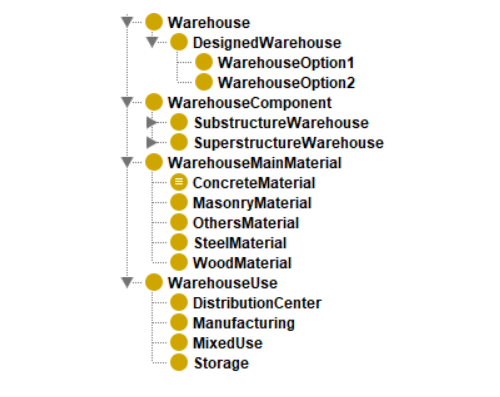Introduction
The ontology is developed by analyzing the domain of warehouse design, identifying important elements such as FlooringWarehouse, RoofingWarehouse, and FoundationWarehouse, along with their respective subclasses like ConcreteFlooringWarehouse, InsulatedFlooringWarehouse, and PileFoundationWarehouse.
This work contributes to the field by offering a detailed ontological framework that can be utilized by architects, engineers, and warehouse designers for planning, analysis, and decision making in warehouse construction and management.
What is the purpose?
The purpose of the warehouse ontology is to provide a structured and systematic representation of various aspects of warehouse design and operation. It aims to cover critical elements such as physical structures, material choices, and functional uses of warehouses. This ontology expects to enhance understanding and communication among professionals involved in warehouse design, construction, and management, facilitating better decision-making and planning.
What is the scope?
Design Variations: Different architectural and functional designs of warehouses.
Structural Components: Both the foundational (basements, flooring, foundations) and the above ground structures (frames, roofing, walls) of warehouses.
Material Selection: In-depth coverage of materials used in warehouse construction. Although material properties was not assigned in that stage, it can be assigned in further researches.
Functional Uses: Diverse operational uses of warehouses, including storage, manufacturing, distribution, and mixed uses. Each can help to determine a warehouse function.
Who are the intended users?
Architects and Civil Engineers: Professionals involved in the design and construction of warehouses.
Warehouse Managers and Logistics Planners: Individuals responsible for the operational planning and management of warehouse facilities.
Supply Chain Analysts: Experts in supply chain management who need to understand warehouse capabilities and limitations.
Academics and Researchers: Individuals in academic and research institutions studying warehouse design and logistics.
What is the intended use?
Facilitating Design and Construction: Assisting architects and engineers in the planning and design of warehouse structures.
Operational Planning and Optimization: Helps warehouse managers and logistics planners in optimizing warehouse layout and operations.
Educational and Research Purposes: Serving as a teaching and research tool in academic settings.
Supply Chain Analysis: Providing supply chain analysts with a comprehensive understanding of warehouse functionalities and capacities.
Creating an Ontology for a Warehouse
The ontology was dissected into four primary subclasses, each further refined into lower-level subclasses to involve the detailed characteristics of warehouse structures. We created classes and then set up properties for these classes. These properties are designed to connect the classes and their reverse functions. This mirrors the two-way relationships that are a key part of warehouse design.
The development of the class hierarchy was guided by a logical structure, moving from general to more specific concepts. In the ontology, this was evident in how the Warehouse class was divided into specific design types and how WarehouseComponent was further divided into substructure and superstructure elements. Further detailing was added, which involves specifying value types. For instance, the class WarehouseOption1 witness the restriction hasRoofType some RoofingWarehouse to denote that any instance of WarehouseOption1 must have a roofing type that is categorized within the broader class of RoofingWarehouse. It emphasizes that each designed option has a specific roofing structure, which may influence factors like insulation, storage conditions, and overall warehouse features.
The development of the warehouse design ontology was a comprehensive and challenging process. This process ensured that the ontology was not only theoretically sound but also applicable to real-world scenarios in the domain of warehouse design and management.
References:
Ontology Development 101: A Guide to Creating Your First Ontology Natalya F. Noy and Deborah L. McGuinness Stanford University, Stanford, CA, 94305

